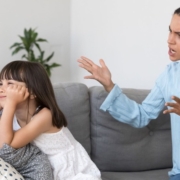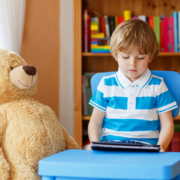Preparing Our Children to Wear Face Masks in the Classroom
When I am out and about and notice people wearing face masks, it feels surreal. I don’t like it, because it reminds me that something is wrong in the world. I am learning to reframe my thoughts, and instead, think about the protection face masks give us to do the things we need and want to do. However, when I see families with children wearing face masks, it never fails to touch me to the core. I look at the children and wonder how they feel about this? What conversations have happened in their homes? Does this feel normal or does it remind them, too, that something is wrong in the world?”
All children are different. Some will have no trouble wearing a mask, some will. All children though, look to their adults’ faces for social cues to know how to feel about new people and situations. When we are wearing masks, this is more difficult for them to figure out. There are ways we can help our children feel more comfortable about wearing a mask, help them read our emotions when we are wearing ours, and encourage them towards success. Here are some helpful tips you can use:
Wearing a Mask
- Read a simple story to teach about masks: https://hello.naeyc.org/HigherLogic/System/DownloadDocumentFile.ashx?DocumentFileKey=bd1bbee0-e18f-4188-aefe-982b9f9d729a
- Introduce the mask in a familiar place – home.
- Explain to your child that the other children in class and the teacher will also be wearing masks.
- Listen to songs about wearing masks: https://youtu.be/VLCp0r1tgaQ
- Involve your child in selecting masks that fit comfortably and feature favorite colors or characters. Alternatively, your child may want to decorate their own mask as a favorite superhero, a favorite color, or simply draw a smile on it. Plan to send back-up masks to school for unexpected messes.
- If the mask is uncomfortable on your child’s ears, try attaching buttons to a hat or headband for looping the elastic around instead of their ears.
- Give your child an opportunity to practice taking their mask on and off, a skill that will be needed in the classroom.
Reading Emotions
- Play ‘Guess my Expression’: Ask your child to guess how you’re feeling from the expression of your eyes and eyebrows. You can show them how the expression in your eyes matches your mouth by taking off your face mask. Then let them have a turn.
- Practice talking to your child through your mask so they will get used to the sounds of voices through a mask.
- Encourage your child to explore and learn through imaginary play. For example, put masks on stuffed animals and dolls.
Tools to Encourage Success
- Practice wearing it at home while playing or watching tv and gradually increase the duration.
- Role model mask wearing.
- Provide language: “I can do it!”
- Offer positive choices: “Do you want to wear your superhero mask or your favorite color mask? Do you want to practice wearing your mask while playing or watching tv? Should I put my mask on by myself, or do you want to help me?”
- Tell their brain to give their body an action: “Tell your hands it’s time to put your mask on.”
- Ask curiosity questions: “Should a mask cover just our mouth or our nose, too?”
- Keep communication positive: “Yes, you can take your mask off as soon as you get home!”
- Acknowledge their feelings: “It feels uncomfortable.” Or “It feels scary.” When we notice and label our children’s emotions in a supportive way, it helps them feel more calm (see my blog Supporting Our Children’s Emotional Health This Fall). Once they feel less anxious, we can introduce logic and problem solving. Give your child power and control by involving them in problem solving. “What can we do to make this work for you?”
- Have faith in your child’s ability: “I believe in you. I trust you. I know you can handle this.”
- Encourage by noticing: “You are doing it!”
When I am out with my mask on and have eye contact with a child, I smile with my eyes – almost to the point of blinking – as a way of acknowledging them with warmth. My hope is that they know there is a smile on my face and feel reassured by that. This is a difficult time for our children and behavior challenges are to be expected. As a certified Child Behavior Specialist and Parent Coach, it is my goal to work together with parents to design a behavior plan that meets individual family needs while using tools that turn conflict into opportunities to teach and learn.











